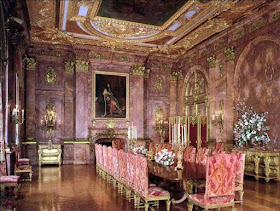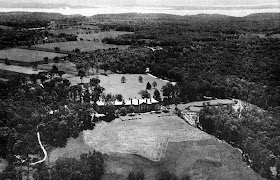 |
| "CHRISTMAS EVE IN COLONIAL TIMES" from a painting by Everett Shinn |
Sunday, December 24, 2017
Monday, October 23, 2017
The Amawalk Arboretum/Lasdon Park and Arboretum
 |
| THE AMAWALK ARBORETUM |
THE AMAWALK ARBORETUM dedicated to the memory of Major Orlando Jay Smith, founder of the Nursery. The plans for the Arboretum have been designed by Vitale, Brinckerhoff & Geiffert, Landscape Architects, under whose supervision we are executing the work. Plans for the executive and display building, in Colonial style, have been designed by Jame Cameron Mackenzie Jr., Architect. Estate owners, park department officials, landscape architects, architects, students and others will be welcomed to the Amawalk Arboretum, and effects of scientific planting will doubtless be of great value and advantage. The above view shows the Arboretum as it will look from the air when completed. From an add in the back of the yearbook for Architectural League of New York 1924.
 |
| https://www.lasdonpark.org |
Property was acquired by William and Mildred Lasdon in 1939. They renamed estate "Cobbling Rock Farm". The main house of the estate was built in 1933 by Dr. Voislawsky after the original house was destroyed by a fire. The house is modeled after George Washington’s home in Virginia.
***My assumption the fire ruined the plans for the arboretum.***
William Lasdon is known for establishing a major pharmaceutical company and for his philanthropist endeavors. The Lasdon estate was simply used as a country retreat. The Lasdon family had great interest in horticulture and loved to travel. Along these travels, they brought back many tree specimens and planted them at the estate. https://www.lasdonpark.org/history/
Sunday, October 22, 2017
INTERIOR TAPESTRY ROOM, RESIDENCE OF EDSON BRADLEY, ESQ., NEWPORT, R. I. Howard Greenley, Architect, New York
 |
| INTERIOR TAPESTRY ROOM(DRAWING ROOM), RESIDENCE OF EDSON BRADLEY, ESQ., NEWPORT, R. I. Howard Greenley, Architect, New York |
Follow THIS LINK for more on "Seaview Terrace, the Edson Bradley, Esq. estate.
Sunday, September 10, 2017
HOUSE OF WILLIAM ZIEGLER, JR., ESQ., EAST 63RD STREET, NEW YORK
 |
| FRONT FACADE HOUSE OF WILLIAM ZIEGLER, JR., ESQ., EAST 63RD STREET FREDERICK J. STERNER, ARCHITECT |
 |
| VIEW FROM FOYER INTO LIVING ROOM HOUSE OF WILLIAM ZIEGLER, JR., ESQ., EAST 63RD STREET FREDERICK J. STERNER, ARCHITECT |
 |
| STAIR HALL HOUSE OF WILLIAM ZIEGLER, JR., ESQ., EAST 63RD STREET FREDERICK J. STERNER, ARCHITECT |
 |
| LIVING ROOM HOUSE OF WILLIAM ZIEGLER, JR., ESQ., EAST 63RD STREET FREDERICK J. STERNER, ARCHITECT |
 |
| DETAIL OF LIVING ROOM DOORWAY HOUSE OF WILLIAM ZIEGLER, JR., ESQ., EAST 63RD STREET FREDERICK J. STERNER, ARCHITECT |
 |
| DINING ROOM HOUSE OF WILLIAM ZIEGLER, JR., ESQ., EAST 63RD STREET FREDERICK J. STERNER, ARCHITECT |
 |
| DINING ROOM FIREPLACE HOUSE OF WILLIAM ZIEGLER, JR., ESQ., EAST 63RD STREET FREDERICK J. STERNER, ARCHITECT |
 |
| LIBRARY HOUSE OF WILLIAM ZIEGLER, JR., ESQ., EAST 63RD STREET FREDERICK J. STERNER, ARCHITECT |
 |
| LIBRARY FIREPLACE HOUSE OF WILLIAM ZIEGLER, JR., ESQ., EAST 63RD STREET FREDERICK J. STERNER, ARCHITECT |
Follow THIS LINK for an earlier post on the residence of William Ziegler, Jr.
Holiday House is returning to The Academy Mansion for 2017.
Friday, August 18, 2017
FESTIVITIES AT NEWPORT MR. VANDERBILT'S MARBLE PALACE THROWN OPEN
Mr. VANDERBILT'S MARBLE PALACE THROWN OPEN.
Newport, R. I. Aug. 19.— The marble palace was thrown open tonight for the first time since its erection, when Mr. and Mrs. W. K. Vanderbilt gave a select dinner party, followed by a musicale. The night was close and oppressive, with dense fog, but inside the gateway a lovely scene presented itself.
When the entire building was illuminated by gas and electricity, the sight was one never before seen in Newport.
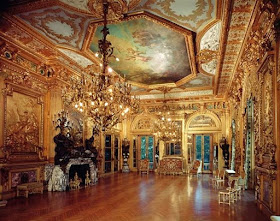 |
| The guests were received in the drawing room, which needed none other than its natural adornment. |
The dining room was truly royal in its appearance and the table was a picture, being laid with a golden service, embellished with the most elaborate and tasteful table decoration ever seen in Newport.
The appointments of the room were in keeping. The floor was covered with a very large fine rug of crimson and gold, inworked with golden fleur de lis at the corners, and the high chairs were of a roseate red velvet, with double principal chairs at the head and foot of the table.
The menu was furnished by Mr. Vanderbilt's chef. The household staff, clad in black liveries with full breast cords and the sleeves and fronts studded with gilt garters and patent leathers with buckles, waited at table.
The guests were Mr. Hoyt, Mr. J. C. Furman, O. H. P. Belmont, Mr. and Mrs. R. M. Hunt, Miss Tooker, Miss Hunewell, Miss Wetmore, Mr. and Mrs. Henry Sloane, Col. and Mrs. Jay, Mr. and Mrs. W. D. Sloane, Mr. Riggs, Miss Sloane, Miss Vanderbilt, and Mr. and Mrs. F. W. Vanderbilt
After dinner a delightful musicale was given, which was attended by a few of the intimate friends of the family.
When "Marble House" was For Sale
Mrs. Belmont's Tea House
http://www.newportmansions.org/explore/marble-house
Friday, July 28, 2017
The Keeper of the Gate - "INISFADA"
Among the most picturesque features of the English countryside are the sturdy lodges that guard the entrance gates to the great estates.
Follow THIS LINK for more on the gate lodge of "Inisfada".
 |
| Built to last down the ages, they are as permanent a part of the landscape as the lordly homes they guard or the trees themselves. |
 |
| But the charming little gate lodge pictured here is not—although it might well be—in England. |
 |
| It is the gate keeper's lodge at "Inisfada", the country home of Nicholas F. Brady, Esq., at Roslyn, Long Island. |
Follow THIS LINK for more on the gate lodge of "Inisfada".
Thursday, July 27, 2017
"I LOVE THE FLAVOR OF CAMELS" says Miss Evelyn Cameron Watts
 |
| MISS WATTS' FEATHER CAPE IS MADE OF THE PLUMAGE OF THE TROPICAL "LOPHOPHORE" BIRD |
"I never get tired of the smooth Camel flavor—the last one I smoke at night tastes just as good as the first in the morning," says the charming debutante daughter of Mr. & Mrs. Harry Dorsey Watts of New York and Baltimore. "And Camels are very mild, too—even when I've smoked a lot, Camels never upset my nerves. And if I'm tired I find that smoking a Camel seems to refresh me—gives me a 'lift' that makes me ready to start all over again."
 |
| Camels are made from finer, MORE EXPENSIVE TOBACCOS ...Turkish and Domestic... than any other popular brand |
It is true that your energy is increased by smoking a Camel. It releases your latent energy in a safe and natural way. When tired, a Camel will drive fatigue and irritability away, and never affect your nerves.
AMONG THE MANY
DISTINGUISHED WOMEN WHO
PREFER CAMEL'S COSTLIER TOBACCOS:
Mrs. Nicholas Biddle - Philadelphia
Miss Mary Byrd - Richmond
Mrs. Powell Cabot - Boston
Mrs. Thomas M. Carnegie Jr. - New York
Mrs. J. Gardner Coolidge, 2nd - Boston
Mrs. Henry Field - Chicago
Miss Anne Gould - New York
Mrs. James Russell Lowell - New York
Mrs. Potter d'Orsay Palmer - Chicago
Friday, July 21, 2017
"TREETOPS" A Small Country House Done in the Italian Manner at Oyster Bay, L. I.
 |
| A good idea of the color treatment of "Treetops" is given by the artist John Floyd Yewell. |
 |
| Reginald T. Townsend, Editor Country Life in America. |
The house was built for Reginald T. Townsend by Architect LOUIS S. WEEKS in 1925. It was during his decade-long tenure as Editor at Country Life in America that he traveled to Alberta and took the first of many journeys with the Trail Riders of the Canadian Rockies. In 1952 the New England Society established the Reginald T. Townsend Award to recognize outstanding achievement representing the finest attributes of the New England character.
Its location and status is unknown to me.
Friday, June 23, 2017
"CAUSMETT" GARDEN TOUR JUNE 23, 1927
 |
| The main house is one of the best examples of Georgian architecture in America. The bricks were specially treated to give a pinkish buff hue. |
 |
| LONG GARDEN, 1953 NOTE THE REMOVED WEST WING |
 |
| LONG GARDEN, 1953 |
In the garden the beds with their many colored flowers are laid out in symmetrical design like carpets of rare workmanship on closely cropped lawns.
 |
| ROCK GARDEN The west end of the house seen from the rock garden set in the hillside below the house. To the right is the formal garden of shrubs and flowers. NOTE THE EXTANT WEST WING |
Another attraction of the estate is the Winter cottage of gray stone now surrounded by flowering shrubs.
 |
| The Sunken Garden was located at the end of the Long Garden. It was part of a planned set of garden terraces down to the beach. It was never completed. |
There is a sunken garden whose flowers are guarded against the strong winds from the water, a tennis court surrounded by flowers, and a drive that leads to a sandy beach.
 |
| Just west of the Main House is a beach access road. The area was blanketed with daffodil bulbs. |
 |
| Sir William Orpen, 1878–1931, Title - Evelyn Marshall Field (Mrs. Marshall Field III), Date ca. 1921. |
The Fields were married in 1915. When this garden tour was held in 1927 it was probable that the couple were beginning to drift apart. Marshall traveled a great deal of the time and socialized assiduously. Evelyn felt the he was bored with the refined, bridge-party social life of sedate upper-class circles. He seemed to prefer a younger and more pleasure seeking crowd. They divorced in 1930.
Caumsett meant "place by sharp rock".
Follow THIS LINK for all posts relating to "Causmett".
The late John Foreman's BIG OLD HOUSES visits "Causmett".
Sunday, June 18, 2017
"CAUMSETT" — MRS. MARSHALL FIELD — FIVE THOUSAND ROSES
Located on the northeast side of the slope overlooking the pond. A small depression had formed from the runoff water emitted by the mansion's ice-making machines and was referred to as a "river" by Audrey Field, 2nd wife of Marshall Field III. Five thousand roses plants, water loving irises and rocks in the stream with a few Japanese Maple trees to provide natural effect were planted. A gazebo with a wrought iron roof and carved sandstone pillars was also installed.
 |
| MRS. MARSHALL FIELD — FIVE THOUSAND ROSES GEORGE STONEHILL, 1933 |
Mrs. Marshall Field—Five Thousand Roses
... all chosen and set out by Mrs. Field herself on the Field estate, Caumsett, at Huntington, Long Island. Most of Caumsett's 2,000 acres are left to their native pink-flowered mountain laurel.
Though the estate is magnificent, the landscaped gardens near the house cover only six acres. The pansies in these rose beds are a favorite rose border, help conceal the great defect of the well-pruned bush—its bare underpinnings. Though rose plants like these average only $1 each, they need soil preparation to a depth of three feet (most plants need only one foot), must be frequently replaced. Modern roses are bigger, brighter, trimmer than the old ones, but less fragrant. Even now a true rosarian can tell two varieties apart in a dark room, detect slight differences in the same rose at different times (they are most fragrant before a storm). Red roses like the one to the right have the strongest fragrance, yellow roses the least.
 |
| Read more HERE. |
 |
| New Life Beyond the Garden Wall September 16, 2000 |
Louise recounts her memories at Causmett in a story relating to the restoration of the walled garden - "Field was married three times, you know. George had to please each of the wives. The first wanted a sunken garden, but she and Mr. Field were divorced before it was finished. So it was never completed. Wife number two wanted a rose garden. So George put in 5,000 roses - it was like rivers of roses. But wife number three didn't want a rose garden so he tore it out."
 Read an excerpt from The Marshall Fields: The Evolution of an American Business Dynasty describing the relationship between Marshall and Audrey during the Depression years HERE. It disputes the above information that she left with no payments of any kind.
Read an excerpt from The Marshall Fields: The Evolution of an American Business Dynasty describing the relationship between Marshall and Audrey during the Depression years HERE. It disputes the above information that she left with no payments of any kind. |
| LIFE Oct 18, 1943 - On his 50th birthday last month Marshall Field III (center) signed the documents bringing him into full control of his grandfather's immense fortune (over $100,000,000). Near $1.5 billion in today's money. |
The late John Foreman's BIG OLD HOUSES visits "Causmett".
Thursday, April 6, 2017
RESIDENCE OF ROBERT S. MOORE MENLO PARK, CALIFORNIA - ALBERT FARR, ARCHITECT
 |
| RESIDENCE OF ROBERT S. MOORE MENLO PARK, CALIFORNIA - ALBERT FARR, ARCHITECT |
 |
| Albert L. Farr |
"It is Mexico, the golden; Mexico, land of sunshine, of fruit and flowers; Mexico, the 'New Spain' of the West. The traditions of the early colonists from the mother country have become a settled heritage in language, customs, buildings, modified sufficiently to meet local conditions of climate and soil.
"In my veins flows the blood of the conquerors. The home I build must recall the land of my forebears; in it I wish reflected the pride and pomp of a noble race, softened by the charm and romance of its devotion to family ties.
"The spirit of hospitality must be evident—that traditional hospitality of the Orient which has become also a tradition of Spain, revered and handed down to Spain's children.
"And, indeed, there must be more than a suggestion of the Orient itself. For Moorish art and imagery are entwined in the life of Spain. Let there be felt, then, subtle influences of Grenada, of the Alhambra; the cool tinkle of water in a thirsty land, a tiled fountain in a courtyard, delicate arabesques and arches, interlacing grilles, recessed balconies.
"But there must be no discord between the old world and the new. Our actual conditions are to be considered ; our climate and countryside, the wealth of verdure, the spread of branch, and the riots of color that succeeding seasons bring. And all the accessories and devices that add to the comfort and convenience of modern life are to be provided. To weld together all these varying elements of the past and the present into a harmonious ensemble—this is the ideal for which I will strive."
 |
| ENTRANCE DRIVEWAY - RESIDENCE OF ROBERT S. MOORE MENLO PARK, CALIFORNIA - ALBERT FARR, ARCHITECT |
 |
| MAIN FACADE - RESIDENCE OF ROBERT S. MOORE MENLO PARK, CALIFORNIA - ALBERT FARR, ARCHITECT |
 |
| DETAIL OF MAIN ENTRANCE - RESIDENCE OF ROBERT S. MOORE MENLO PARK, CALIFORNIA - ALBERT FARR, ARCHITECT |
 |
| THE MIRROR POOL - RESIDENCE OF ROBERT S. MOORE MENLO PARK, CALIFORNIA - ALBERT FARR. ARCHITECT |
 |
| CARRIAGE COURT GATEWAY - RESIDENCE OF ROBERT S. MOORE MENLO PARK, CALIFORNIA - ALBERT FARR, ARCHITECT |
 |
| THE LAWN - RESIDENCE OF ROBERT S. MOORE MENLO PARK, CALIFORNIA - ALBERT FARR, ARCHITECT |
 |
| OAKS AND LAWN - RESIDENCE OF ROBERT S. MOORE MENLO PARK, CALIFORNIA - ALBERT FARR, ARCHITECT |
This lawn, with its splendid surrounding oaks, is obviously intended by nature and art for an open air annex to the living quarters of the house ; and the walled rose garden for similar use when greater seclusion or shelter is desirable.
 |
| ROSE GARDEN FROM TERRACE - RESIDENCE OF ROBERT S. MOORE MENLO PARK, CALIFORNIA - ALBERT FARR. ARCHITECT |
 |
| THE HOUSE FROM SOUTH GARDEN RESIDENCE OF ROBERT S. MOORE - ALBERT FARR, ARCHITECT |
 |
| THE HOUSE FROM WEST GARDEN RESIDENCE OF ROBERT S. MOORE - ALBERT FARR, ARCHITECT |
 |
| MAIN FLOOR PLAN RESIDENCE OF ROBERT S. MOORE - ALBERT FARR, ARCHITECT |
 |
| FOUNTAIN IN PATIO - RESIDENCE OF ROBERT S. MOORE MENLO PARK, CALIFORNIA - ALBERT FARR, ARCHITECT |
 |
| PATIO - RESIDENCE OF ROBERT S. MOORE MENLO PARK, CALIFORNIA - ALBERT FARR, ARCHITECT |
 |
| PATIO TOWARD LIVING PORCH - RESIDENCE OF ROBERT S. MOORE MENLO PARK, CALIFORNIA - ALBERT FARR, ARCHITECT |
 |
| PATIO - RESIDENCE OF ROBERT S. MOORE MENLO PARK, CALIFORNIA - ALBERT FARR, ARCHITECT |
 |
| PATIO AT NIGHT - RESIDENCE OF ROBERT S. MOORE MENLO PARK, CALIFORNIA - ALBERT FARR, ARCHITECT |
 |
| LIVING PORCH - RESIDENCE OF ROBERT S. MOORE MENLO PARK, CALIFORNIA - ALBERT FARR, ARCHITECT |
 |
| FOUNTAIN IN LIVING PORCH RESIDENCE OF ROBERT S. MOORE - ALBERT FARR, ARCHITECT |
 |
| STAIR HALL TO PRIVATE SUITES - RESIDENCE OF ROBERT S. MOORE MENLO PARK, CALIFORNIA - ALBERT FARR, ARCHITECT |
When these rooms are completely and consistently furnished the interior of the house will acquire the distinctive character which the exterior already possesses; for, although barely finished, this house and its setting have already acquired individuality and harmony.
THE GARDENS
 |
| PLOT PLAN RESIDENCE OF ROBERT S. MOORE - ALBERT FARR, ARCHITECT |
Two big factors enter into the element of quick results in garden construction: First, broad sweeps of lawn, and second, the purchase of large-sized nursery stock. By largest size nursery stock, we do not mean a full grown tree, but simply the largest size of stock that a nursery can handle with practical results. Thus in our selection of the nursery stock for this place only the very finest and largest specimens were purchased. It is a peculiar fact that there are no single nurseries in this State that contain the best stock of all varieties. The immense number of ornamentals which thrive successfully in California make it impossible for nurseries to specialize in everything, and we have found after much experience that it usually takes at least a dozen nurseries to supply every variety in a large plan if the best stock is desired. In this garden seventeen nurseries were patronized to obtain the stock necessary. Incidentally this is one of the big reasons why it does not pay to place the development of a garden plan in the hands of any one nursery.
 |
| John William Gregg |
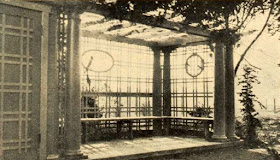 |
| SUMMER HOUSE - RESIDENCE OF ROBERT S. MOORE MENLO PARK, CALIFORNIA - ALBERT FARR, ARCHITECT |
 |
| OPEN-AIR FIREPLACE - RESIDENCE OF ROBERT S. MOORE MENLO PARK, CALIFORNIA - ALBERT FARR, ARCHITECT |
This compact little group of attractions exemplify the out-of-door living-room idea, and will be used continually in good seasons of the year.
 |
| GARAGE RESIDENCE OF ROBERT S. MOORE - ALBERT FARR, ARCHITECT |
 |
| The property in 1941 showing the long driveway of poplars. |
 |
| The property today, now in the town of Atherton. |
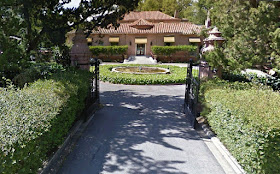 |
| The house today minus its Churrigueresque. |
 |
| Moore Dry Dock Company |
| The Stanford Daily, Volume 77, Issue 19, 27 February 1930 |
ROBERT MOORE WILLS $30,000 TO UNIVERSITY
Bequest Giving Memorial Scholarship Is Probated In Redwood City Court
University of California Receives Like Gift From San Francisco Financier
By the terms of the will of Robert S. Moore of San Francisco and Menlo Park, filed for probate yesterday in the superior court in Redwood City, Stanford is to receive a gift of $110,000 for a scholarship fund to he Known as the Robert S. Moore scholarship. The University of California received a similar bequest to establish a Florence Moore scholarship. According to Acting President Swain, the University authorities have not been informed of the exact nature of the scholarship or its purpose. Dr. Swain declared that the gift had come out of a clear sky. Moore, a prominent San Francisco capitalist, was president of the Pacific Securities Company, chairman of the hoard of directors of the Paraffine Companies Ltd., and associated with the Risdon Iron Works and Moore Shipbuilding Company, he left an estate of over a million dollars, the greater part of which will go to his wife, Mrs. Florence Moore. One bequest of $50,000 goes to the San Francisco Community Chest. Another gift is one of $5,000 to the San Francisco Society for the Prevention of Cruelty to Animals. Besides the two universities and Mrs. Moore, there are a number of smaller beneficiaries of the will. The well-known Menlo Park resident died February 16 in San Francisco. Moore was 73 years of age at the time of his death.
 |
| Florence Moore Hall |




